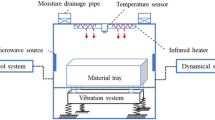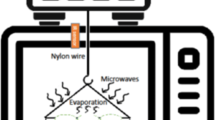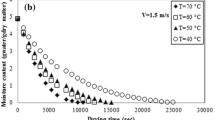Abstract
Mango ginger (Curcuma amada) was dried in a through-flow dryer system at different temperatures (40–70 °C) and air velocities (0.84 – 2.25 m/s) to determine the effect of drying on drying rate and effective diffusivity. As the temperature and air velocity increased, drying time significantly decreased. Among the ten different thin layer drying models considered to determine the kinetic drying parameters, semi empirical Midilli et al., model gave the best fit for all drying conditions. Effective moisture diffusivity varied from 3.7 × 10−10 m2/s to 12.5 × 10−10 m2/s over the temperature and air velocity range of study. Effective moisture diffusivity regressed well with Arrhenius model and activation energy of the model was found to be 32.6 kJ/mol. Artificial neural network modeling was also employed to predict the drying behaviour and found suitable to describe the drying kinetics with very high correlation coefficient of 0.998.






Similar content being viewed by others
References
Akpinar EK (2006) Determination of suitable thin layer drying curve model for some vegetables and fruits. J Food Eng 73:75–84
Babalis SJ, Papanicolaou E, Kyriakis N, Belessiotis VG (2006) Evaluation of thin layer drying models for describing drying kinetics of figs (Ficus carica). J Food Eng 75:205–214
Crank J (1975) Mathematic of diffusion, 2nd edn. Oxford University Press, London, pp 267–268
Diamante LM, Munro PA (1993) Mathematical modeling of the thin layer solar drying of sweet potato slices. Sol Energy 51:271–276
Diamante LM, Ihns R, Savage GP, Vanhanen L (2010) A new mathematical model for thin layer drying of fruits. Int J Food Sci Technol 45:1956–1962
Doymaz I (2004) Convective air drying characteristics of thin layer carrots. J Food Eng 61:359–364
Doymaz I (2005) Drying characteristics and kinetics of okra. J Food Eng 69:275–279
Doymaz I, Pala M (2002) Hot air drying characteristics of red pepper. J Food Eng 55:331–335
Duc LA, Han JW, Keum HD (2011) Thin layer drying characteristics of rapeseed. J Stored Prod Res 47:32–38
Erenturk S, Erenturk K (2007) Comparison of genetic algorithm and neural network approaches for the drying process of carrot. J Food Eng 78:905–912
Erenturk K, Erenturk S, Tabil LG (2004) A comparative study for the estimation of dynamical drying behavior of Echinacea angustifolia: regression analysis and neural network. Comput Electron Agr 45:71–90
Ertekin C, Yaldiz E (2004) Drying of eggplant and selection of a suitable thin layer drying model. J Food Eng 63:349–359
Esturk O (2012) Intermittent and Continuous microwave-convective air drying characteristics of sage (Salvia officinalis) leaves. Food Bioprocess Technol 5:1664–1673
Falade KO, Solademi OJ (2010) Modeling of air drying of fresh and blanched sweet potato slices. Int J Food Sci Technol 45:278–288
Golap SG, Bandyopadhyaya C (1984) Characterization of mango-like aroma in Curcuma amada Roxb. J Agr Food Chem 32:57–59
Guine RPF, Francisca H, Barroca MJ (2012) Mass transfer coefficients for the drying of pumpkin (Cucurbita moschata) and dried product quality. Food Bioprocess Technol 5:176–183
Gunhan T, Demir V, Hancioglu E, Hepbasli A (2005) Mathematical modeling of drying of bay leaves. Energy Convers Manag 46:1667–1679
Hernandez-Perez JA, Garcia-Alvarado MA, Trystram G, Heyd B (2004) Neural networks for heat and mass transfer prediction during drying of cassava and mango. Innov Food Sci Emerg Technol 5:57–64
Hii CL, Law CL, Cloke M (2009) Modelling using a new thin layer drying model and product quality of cocoa. J Food Eng 90:191–198
Jain D, Pathare PB (2004) Selection and evaluation of thin layer drying models for infrared radiative and convection drying of onion slices. Biosyst Eng 89:289–296
Karim A, Hawlader MNA (2005) Drying characteristics of banana: theoretical modeling and experimental validation. J Food Eng 70:35–45
Krishna Murthy TP, Manohar B (2012) Microwave drying of mango ginger (curcuma amada roxb): prediction of drying kinetics by mathematical modelling and artificial neural network. Int J Food Sci Technol 47:1229–1236
Lertworasirikul S (2008) Drying kinetics of semi-finished cassava crackers: a comparative study. LWT-Food Sci Technol 41:1360–1371
Liu X, Chen X, Wu W, Peng G (2007) A neural network for predicting moisture content of grain drying process using genetic algorithm. Food Control 18:928–933
Martynenko AI, Yang SX (2006) Biologically inspired neural computation for ginseng drying rate. Biosyst Eng 95:385–396
McMinn WAM (2006) Thin-Layer modelling of the convective, microwave, microwave-convective and microwave-vacuum drying of lactose powder. J Food Eng 72:113–123
Midilli A, Kucuk H (2003) Mathematical modelling of thin layer drying of pistachio by using solar energy. Energy Convers Manag 44:1111–1122
Midilli A, Kucuk H, Yapar ZA (2002) New model for single layer drying. Dry Technol 20:1503–1513
Movagharnejad K, Nikzad M (2007) Modeling of tomato drying using artificial network. Comput Electron Agr 59:78–85
Mujumdar AS, Law CL (2010) Drying technology: trends and applications in post-harvest processing. Food Bioprocess Technol 3:843–852
Mujumdar AM, Naik DG, Dandge CN, Puntambekar HM (2000) Anti-inflammatory activity of Curcuma amada Roxb. in albino rats. Indian J Pharmacol 32:375–377
Okos MR, Narsimhan G, Singh RK, Witnauer AC (1992) Food dehydration. In: Heldman DR, Lund DB (eds) Handbook of food engineering. Marcel Dekker, New York
Ozbek B, Dadalli G (2007) Thin-layer drying characteristics and modelling of mint leaves undergoing microwave treatment. J Food Eng 83:541–549
Ozdemir M, Devres YO (1999) The thin layer drying characteristics of hazelnuts during roasting. J Food Eng 42:225–233
Park KJ, Vohnikova Z, Bord FPR (2002) Evaluation of drying parameters and desorption isotherms of garden mint leaves. J Food Eng 51:193–199
Policegoudra RS, Aradhya SM (2008) Structure and biochemical properties of starch from an unconventional source - a mango ginger (Curcuma amada Roxb.) rhizome. Food Hydrocoll 22:513–519
Policegoudra RS, Abiraj K, Channe Gowda D, Aradhya SM (2007a) Isolation and characterization of antioxidant and antibacterial compound from mango ginger (Curcuma amada Roxb.) rhizome. J Chromatogr B 852:40–48
Policegoudra RS, Divakar S, Aradhya SM (2007b) Identification of Difurocumenonol, a new antimicrobial compound isolated from mango ginger (Curcuma amada Roxb.) rhizome. J Appl Microbiol 102:1594–1602
Policegoudra RS, Aradhya SM, Singh L (2011) Mango ginger (Curcuma amada Roxb.) – A promising spice for phytochemicals and biological activities. J Biosci 36:739–748
Prakash D, Suri S, Upadhyay G, Singh B (2007) Total phenol, antioxidant and free radical scavenging activities of some medicinal plants. Int J Food Sci Nutr 58:18–28
Ramesh MN, Kumar MA, rao Srinivasa PN (1996) Application of artificial neural networks to investigate the drying of cooked rice. J Food Process Eng 19(3):321–329
Rao AS, Rajanikanth B, Seshadri R (1989) Volatile aroma components of Curcuma amada Roxb. J Agr Food Chem 37:740–743
Roberts JS, Kidd DR, Padilla-Zakour O (2008) Drying kinetics of grape seeds. J Food Eng 89:460–465
Sacilik K, Elicin AK (2006) The thin layer drying characteristics of organic apple slices. J Food Eng 73:281–289
Sasikumar B (2005) Genetic resources of curcuma: diversity, characterization and utilization. Plant Genet Resour 3:230–251
Shittu TA, Raji AO (2011) Thin layer drying of African breadfruit (Treculia Africana) seeds: modeling and rehydration capacity. Food Bioprocess Technol 4:224–231
Simal S, Femenia A, Garau M, Crosello C (2005) Use of exponential Page’s and diffusional models to simulate the drying kinetics of kiwi fruit. J Food Eng 66:323–328
Singh G, Singh OP, Maurya S (2002) Chemical and biocidal investigations on essential oils of some Indian Curcuma species. Prog Cryst Growth Charact Mater 45:75–81
ASTA (American Spice Trade Association) (1985) Official analytical method of the American Spice Trade Association. New Jersey
Sun DW, Byrne C (1998) Selection of EMC/ERH isotherm equations for rapeseed. J Agr Eng Res 69:307–315
Togrul IT (2010) Modelling of heat and moisture transport during drying black grapes. Int J Food Sci Technol 45:1146–1152
Tutuncu MA, Labuza TP (1996) Effect of geometry on the effective moisture transfer diffusion coefficient. J Food Eng 30:433–447
Uribe E, Vega-Galvez A, Scala KD, Oyanadel R, Torrico JS, Miranda M (2011) Characteristics of convective drying of pepino fruit (Solanum Muricatum AIt): application of Weibull distribution. Food Bioprocess Technol 4:1349–1356
Wang Z, Sun J, Liao X, Chen F, Zhao G, Wu J, Hu X (2007) Mathematical modelling on hot air drying of thin layer apple pomace. Food Res Int 40:39–46
Author information
Authors and Affiliations
Corresponding author
Electronic supplementary material
Below is the link to the electronic supplementary material.
ESM 1
(DOCX 21 kb)
Rights and permissions
About this article
Cite this article
Murthy, T.P.K., Manohar, B. Hot air drying characteristics of mango ginger: Prediction of drying kinetics by mathematical modeling and artificial neural network. J Food Sci Technol 51, 3712–3721 (2014). https://doi.org/10.1007/s13197-013-0941-y
Revised:
Accepted:
Published:
Issue Date:
DOI: https://doi.org/10.1007/s13197-013-0941-y




